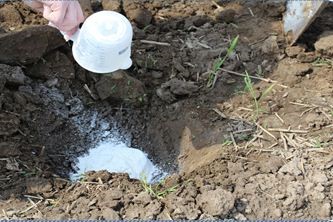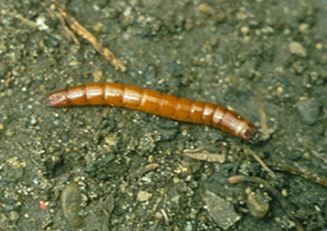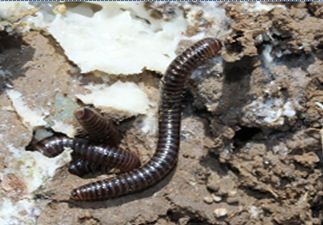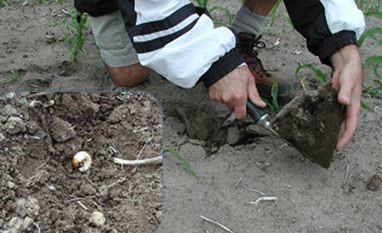Scouting for soil insect pests in field crops
Learn the importance of scouting for soil insect pests to assess the risk to field crops.
Overview
Insecticide seed treatments have proven to provide effective and efficient protection for soil insects in field crops. As the level of adoption of this technology has increased, there has been a shift from the prescriptive use of insecticide seed treatments to a more prophylactic use. The broader use of insecticide seed treatments increases the risk of exposure to non-target organisms.
This shift in approach to the use of insecticide seed treatments increases the need to re-establish an Integrated Pest Management (IPM) approach in field crops, where insecticide seed treatments are targeted for use only in those fields deemed at risk of soil insect pest infestations.
IPM is an approach to pest management that integrates all available practices and technologies to keep pest populations below threshold in an economically viable way while minimizing the impact to the environment. Some of the first steps to IPM are to better understand each pest, their life cycle and impact to the crop as well as scouting to assess the risk of these pests so that preventative and cultural measures can be timed appropriately.
Factors that increase risk
Certain factors put some fields more at risk of soil insect pests than others. These factors include soil type, crop history/rotation and pre-plant weed and nutrient management practices. For example, wireworms are strongly attracted and survive best in fields with sandy or silty soil types that have a frequent grass crop rotation (cereals, mixed forages, grassy weeds), or follow canola or vegetable crops including carrots, sugar beets and potatoes.
Fields planted after newly broken sod or pasture in the last two years are also at high risk. Fields that do not fit these conditions are less likely to be at risk. Similarly, certain conditions place fields at risk of other insect pests including grubs, seedcorn maggot, black cutworm and others. Fields that do not fit these conditions are less likely at risk and do not need an insecticide seed treatment for protection each year.
Scouting for confirmation
Scouting is always the best method to determine if fields are actually at risk. Fall scouting can predict spring infestations of both wireworms and grubs since the same population present in the soil in the fall will also be present in the spring. This is a recommended practice even for those growers with a known history of wireworm and grub infestations.
Neonicotinoid seed treatments do not control wireworms or grubs but intoxicate the larvae once they have taken a bite of the treated seed or seedling, causing them to stop feeding long enough for the seedling to get established. The insecticide does not reduce the pest populations and may require the use of the high rate of insecticide if conditions are ideal for pest populations to increase that year. Additional cultural methods like tillage or adjusting planting times may also be required to help reduce the risk of crop injury if pest populations are high.
Spring time assessments help determine what impact winter and early spring conditions have had on the early season pests. Harsh winters can have a large impact on bean leaf beetles for example, while grubs are well protected from extreme temperature fluctuations by hibernating below the frost line. Spring scouting is also the best time to monitor for those pests that overwinter in the U.S. and migrate here in early spring (for example: black cutworm).
Scouting prior to planting informs growers of field conditions that have increased their risk to pests. Some additional cultural control measures could be implemented or decisions made as to where to best target the insecticide seed treatments. Fields found to be at low risk of the major soil insect pests can targeted for planting fungicide-only treated seed in and experience little to no crop loss due to these insects.
The focus of this infosheet is how to use baits to find wireworm populations and how to dig and assess for grubs and some of the key root feeding pests. The Guide to Early Season Field Crop Pests provides additional information on how to scout for other soil insects.
Wireworm baits
Wireworm larvae can live for up to six years in the same field, making baits an ideal method for monitoring. Baits are also easy to set up requiring only a shovel, soil thermometer, bag of flour, measuring cup and flags.
In the fall or spring when soil is moist and temperatures are just above 10°C
For each bait, dig a hole, approximately 15 centimetres (6 inches) wide and deep. Take 1 cup of all purpose flour and drop it into the hole (Figure 1). Bury the bait, breaking up any soil clumps and mound the soil to prevent standing water. Place a flag at the bait station to make it easier to find again and return seven days later to dig the bait out and determine the presence of wireworms.

Bait threshold: One wireworm/bait indicates the need for an insecticide seed treatment. Millipedes may also be found in the baits.
Identifying wireworms and millipedes
Wireworm baits can capture both wireworms and millipedes. It is important to properly identify these two pests since insecticide seed treatments only provide protection against wireworms, not millipedes.
Wireworm larvae are hard bodied, cylindrical, slightly shiny and copper in colour with a distinctive flat head (Figure 2). Newly hatched larvae are white and soft bodies before turning hard and coppery in colour. Wireworms only have three pairs of legs near the front of the body.

Millipedes are hard-shelled, cylindrical and dark reddish brown to grey-black in colour (Figure 3). Millipedes are not insects but are arthropods and have many legs; two short pairs of legs per body segment. Immature millipedes are whitish yellow in colour and have fewer legs than the adults. Both adults and immatures coil up tight when disturbed. Both stages can feed on seeds and seedlings.

Digging and visual assessment
Fall Scouting
Assessments for grubs or wireworms can be done in the fall after harvest, before the ground freezes. The grub or wireworm population present in the fall will be what is present in the spring at planting time.
Scout in high risk areas of the field first, including sandy or silty knolls, near tree lines, weedy patches and known problem areas that had gaps in plant stand in the past.
Use a shovel or trowel to dig up approximately 30 cm2 (1 ft2) of soil about 7 to 10 cm (3 to 4 in.) deep in at least five areas of the field. Sift through the soil by hand, breaking up any clumps and count the number of insects in the sample. Look for clipped roots or any other signs of feeding on the new seedling, both below and above ground. Sort and count any insects present.

Information on all early season insect pest identification and thresholds can be found in the Guide to Early Season Field Crop Pests and Agronomy Guide for Field Crops.
Spring Scouting
Other insects and pests may be present during spring scouting including seedcorn maggot, black cutworm and other cutworms, bean leaf beetle and slugs. Follow the same scouting procedures as described under fall scouting. If the crop has already been planted, find areas of the field where there are gaps in the stand or wilting seedlings. Go to the next nearest surviving plant in the row and dig the roots of that seedling to look for any pests present.
If more assistance is required in identification, take a high resolution, in-focus photograph of the pest or place the insect or pest in a vial of alcohol or hand sanitizer and send it to an agronomist or an Ontario Ministry of Agriculture, Food and Rural Affairs (OMAFRA) pest specialist. Samples can also be submitted to:
University of Guelph
Laboratory Services Division Pest Diagnostic Clinic
95 Stone Road West
Guelph, ON N1H 8J7
Footnotes
- footnote[*] Back to paragraph Baits are most effective when soil temperatures are just above 10°C, so that the flour releases CO2 to attract wireworms. Dry soil conditions can reduce the effectiveness of the bait.